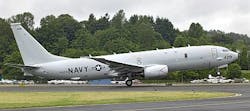Obsolete before deployment: Boeing to update P-8A electronic warfare components to stave-off obsolescence
PATUXENT RIVER NAS, Md., 21 Oct. 2012. The U.S. Navy is asking the Boeing Co. in Seattle to upgrade electronic warfare (EW) subsystems in the P-8A Poseidon Multi-Mission Maritime aircraft to overcome obsolescence issues -- ever before the new maritime patrol jet is deployed to active-duty Navy flight squadrons.
Officials of U.S. Naval Air Systems Command at Patuxent River Naval Air Station Md., awarded Boeing an $8.5 million contract Thursday to update the electronic support measures (ESM) sensor digital measurement unit of the P-8A to ensure the EW components are not obsolete by the time the aircraft is widely fielded.
The P-8A, a military variant of the Boeing 737 jetliner, first flew in 2009, and was approved for low-rate production the following year. The first production version of the aircraft was handed over to the Navy last March. Initial operating capability of the P-8A is not expected until next year.
Obsolescence in new weapon systems is a common problem among U.S. Department of Defense major systems that can take years, if not decades, to design, manufacture, and deploy.
ESM involves search, interception, identification, and location of enemy radar or radio communications. Other onboard EW systems then can jam or avoid the enemy radio signals. The Northrop Grumman Corp. Electronic Systems segment in Linthicum, Md., is in charge of the P-8 EW systems.
Northrop Grumman is supplying the P-8's electronic warfare self-protection (EWSP) suite, which includes the Terma AN/ALQ-213(V) electronic warfare management system (EWMS), directional infrared countermeasures (DIRCM) set, radar warning system, and BAE Systems countermeasures dispenser. Just this month the Northrop Grumman ESM system for the P-8A was officially designated the AN/ALQ-240(V)1.
Ultimately, the Navy plans to buy 108 P-8A aircraft from Boeing to replace the service’s fleet of 196 P-3C Orion maritime patrol aircraft, which are approaching the end of operational life. The P-3 is a version of the Lockheed Martin Electra four-engine turboprop aircraft.
The P-8A is a specially hardened and reinforced version of the Boeing 737 passenger jet, and is designed to operate at extremely low altitudes over the ocean during close-in searches for potentially hostile submarines. The P-8A is designed to withstand the rigors of low-altitude turbulence and exposure to salt spray.
The Boeing P-8A Poseidon, a Navy version of the 737 jetliner, will replace the P-3 Orion for long-range maritime patrol and anti-submarine warfare.
The Boeing P-8A Poseidon, a Navy version of the 737 jetliner, will replace the P-3 Orion for long-range maritime patrol and anti-submarine warfare.
Navy officials plan to use the P-8A in tandem with the Northrop Grumman RQ-4N Broad Area Maritime Surveillance (BAMS) unmanned aerial vehicle (UAV) -- a maritime-patrol version of the Global Hawk long-range surveillance UAV. Plans call for using BAMS to detect potentially hostile submarines and surface ships, and upon detection, to call in the P-8A to take a closer look or to attack hostile vessels with torpedoes and missiles.
Boeing will build the Poseidon aircraft at its factory in Renton, Wash. The 737 fuselage and tail sections will be built by Spirit AeroSystems in Wichita, Kan., then transferred to Renton where all structural features will be incorporated in sequence during fabrication and assembly.
The P-8A’s flight management system and the stores management system have been developed by GE Aviation Systems in Grand Rapids, Mich. (formerly Smiths Aerospace). The cabin has as many as seven operator consoles.
The Poseidon’s MX-20HD digital electro-optical and infrared (EO/IR) multi-spectral sensor turrets come from L-3 Communications Wescam in Burlington, Ontario. The MX-20HD is gyro-stabilized and can have as many as seven sensors, including infrared, CCDTV, image intensifier, laser rangefinder, and laser illuminator.
The aircraft has the upgraded APS-137D(V)5 maritime surveillance radar and signals intelligence (SIGINT) system from the Raytheon Co. Space and Airborne Systems (SAS) segment in McKinney, Texas.
The APS-137D(V)5 radar, which is installed on the P-8’s enlarged nose fairing, provides synthetic aperture radar (SAR) for imaging stationary ships and small vessels, coastal and overland surveillance, and high-resolution imaging synthetic aperture radar (ISAR) for imaging surfaced submarines and fast surface vessels operating in coastal waters.
The P-8A will have the CAE Inc. advanced integrated magnetic anomaly detection (MAD) system. The Navy plans to arm the P-8A with the MK 54 torpedo.
Boeing will supervise most of the work under the current contract at Northrop Grumman in Linthicum, Md. Boeing will do other work on the contract in Seattle, and should be finished with the job in April 2015.
For more information contact Boeing online at www.boeing.com, Northrop Grumman Electronic Systems at www.es.northropgrumman.com, or Naval Air Systems Command at www.navair.navy.mil.
Follow Military & Aerospace Electronics and Avionics Intelligence news updates on Twitter
